Fire Behavior Simulation from Global Fuel and Climatic Information
Abstract
:1. Introduction
2. Materials and Methods
2.1. Fuel Dataset
- A global fuelbed map (Figure 2), with a spatial resolution of 10 arc seconds (approx. 300 m at the Equator), based on land cover and biomes information, and
- A database that includes the parameters of each fuelbed that affect fire behavior and effects.
2.2. Climatic Data Source
2.3. Slope
- Slope class (SP) 1: 0% slope assigned in FCCS (for slopes between 0 and 5%),
- Slope class (SP) 2: 30% slope assigned in FCCS (for slopes between 5 and 45%),
- Slope class (SP) 3: 70% slope assigned in FCCS (for slopes higher than 45%).
2.4. Fuel Moisture Content
- 0: clear sky, less than 10% cloud cover,
- 1: scattered clouds, between 10 and 50% cloud cover,
- 2: broken clouds, between 60 and 90% cloud cover, and
- 3: overcast, 100% cloud cover.
- D1L1: 10 h FMC < 5.5%
- D2L2: 5.5% ≤ 10 h FMC < 8.5%
- D3L3: 8.5% ≤ 10h FMC < 10.5%
- D4L4: 10 h FMC ≥ 10.5%
2.5. Wind Speed
- Wind Class (WC) 1: 0–1.0 m·s−1 (0–2.24 mph). Assigned to 1.0 mph in FCCS.
- Wind Class (WC) 2: 1.0–2.5 m·s−1 (2.24–5.59 mph). Assigned to 4 mph in FCCS.
- Wind Class (WC) 3: 2.5–5 m·s−1 (5.59–11.18 mph). Assigned to 7 mph in FCCS.
2.6. Fire Behavior
3. Results
3.1. Environmental Conditions
3.2. Fire Behavior
4. Discussion
4.1. Environmental Conditions
4.2. Fire Behavior
5. Conclusions
Supplementary Materials
Acknowledgments
Author Contributions
Conflicts of Interest
References
- Rothermel, R.C. How to Predict the Spread and Intensity of Forest and Range Fires; INT-143; National Wildfire Coordinating Group, USDA Forest Service Intermountain Research Station: Boise, ID, USA, 1983; p. 166.
- Achard, F.; Eva, H.D.; Mollicone, D.; Beuchle, R. The effect of climate anomalies and human ignition factor on wildfires in Russian boreal forests. Philos. Trans. R. Soc. Lond. B Biol. Sci. 2008, 363, 2331–2339. [Google Scholar] [CrossRef] [PubMed]
- Jolly, W.M.; Cochrane, M.A.; Freeborn, P.H.; Holden, Z.A.; Brown, T.J.; Williamson, G.J.; Bowman, D.M.J.S. Climate-induced variations in global wildfire danger from 1979 to 2013. Nat. Commun. 2015, 6, 7537. [Google Scholar] [CrossRef] [PubMed]
- Flannigan, M.D.; Harrington, J.B. A study of the relation of meteorological variables to monthly provincial area burned by wildfire in Canada (1953–1980). J. Appl. Meteorol. 1988, 27, 441–452. [Google Scholar] [CrossRef]
- Flannigan, M.D.; Stocks, B.J.; Wotton, B.M. Climate change and forest fires. Sci. Total Environ. 2000, 262, 221–229. [Google Scholar] [CrossRef]
- Flannigan, M.; Cantin, A.S.; de Groot, W.J.; Wotton, M.; Newbery, A.; Gowman, L.M. Global wildland fire season severity in the 21st century. For. Ecol. Manag. 2013, 294, 54–61. [Google Scholar] [CrossRef]
- De Groot, W.J.; Flannigan, M.D.; Cantin, A.S. Climate change impacts on future boreal fire regimes. For. Ecol. Manag. 2013, 294, 35–44. [Google Scholar] [CrossRef]
- Andrews, P.L.; Bevins, C.D.; Seli, R.C. BehabePlus Fire Modeling System Version 4.0. User Guide.; RMRS-GTR-106WWW; USDA Forest Service, Rocky Mountain Research Station: Fort Collins, CO, USA, July 2008; p. 123. [Google Scholar]
- Cohen, J.D.; Deeming, J.E. The National Fire-Danger Rating System: Basic Equations; General Technical Report PSW-82; USDA Forest Service, Pacific Southwest Forest and Range Experiment Station: Berkeley, CA, USA, 1985; p. 23. [Google Scholar]
- Stocks, B.J.; Lawson, B.D.; Alexander, M.E.; Van Wagner, C.E.; McAlpine, R.S.; Lynham, T.J.; Dubé, D.E. Canadian Forest Fire Danger Rating System: An overview. For. Chron. 1989, 65, 258–265. [Google Scholar] [CrossRef]
- Ottmar, R.D.; Sandberg, D.V.; Riccardi, C.L.; Prichard, S.J. An overview of the Fuel Characteristic Classification System—Quantifying, classifying, and creating fuelbeds for resource planning. Can. J. For. Res. 2007, 37, 2383–2393. [Google Scholar] [CrossRef]
- Scott, J.H.; Burgan, R.E. Standard Fire Behavior Fuel Models: A Comprehensive Set for Use with Rothermel's Surface Fire Spread Model; RMRS-GTR-153; USDA Forest Service, Rocky Mountain Research Station: Fort Collins, CO, USA, 2005; p. 80. [Google Scholar]
- Cheyette, D.; Rupp, T.S.; Rodman, S. Developing Fire Behavior Fuel Models for the Wildland-Urban Interface in Anchorage, Alaska. West. J. Appl. For. 2008, 23, 149–155. [Google Scholar]
- Elia, M.; Lafortezza, R.; Lovreglio, R.; Sanesi, G. Developing Custom Fire Behavior Fuel Models for Mediterranean Wildland–Urban Interfaces in Southern Italy. Environ. Manag. 2015, 56, 754–764. [Google Scholar] [CrossRef] [PubMed]
- Zhi, W.W.; Hong, S.H.; Yu, C.; Zhi, H.L.; Hong, W.C. Development of customized fire behavior fuel models for boreal forests of Northeastern China. Environ. Manag. 2011, 48, 1148–1157. [Google Scholar]
- De Groot, W.J.; Goldammer, J.G.; Keenan, T.; Brady, M.A.; Lynham, T.J.; Justice, C.O.; Csiszar, I.A.; O’Loughlin, K. Developing A Global Early Warning System for Wildland Fire. In Proceedings of the V International Conference on Forest Fire Research, Coimbra, Portugal, 27–30 November 2006. [Google Scholar]
- San Miguel-Ayanz, J.; Schulte, E.; Schmuck, G.; Camia, A.; Strobl, P.; Liberta, G.; Giovando, C.; Boca, R.; Sedano, F.; Kempeneers, P.; et al. Comprehensive Monitoring of Wildfires in Europe: The European Forest Fire Information System (EFFIS). In Approaches to Managing Disaster—Assessing Hazards, Emergencies and Disaster Impacts; Tiefenbacher, J., Ed.; InTech: Rijeka, Croatia, 2012; pp. 87–108. [Google Scholar]
- Van Wagner, C.E. Development and Structure of the Canadian Forest Fire Weather Index System; Canadian Forestry Service: Ottawa, ON, Canada, 1987; p. 37. [Google Scholar]
- EFFIS—European Forest Fire Information System. Fire Danger Forecast Technical Background. Available online: http://effis.jrc.ec.europa.eu/about-effis/technical-background/fire-danger-forecast/ (accessed on 29 April 2017).
- Department of National Parks—Wildlife and Plant Conservation—Thailand. Fine-Resolution Forecast Products of Fire Danger Rating. Available online: http://www2.dnp.go.th/gis/FDRS/FDRS.php (accessed on 30 April 2017).
- Dowdy, A.J.; Mills, G.A.; Finkele, K.; de Groot, W.J. Australian Fire Weather as Represented by the McArthur Forest Fire Danger Index and the Canadian Forest Fire Weather Index. Available online: http://www.cawcr.gov.au/technical-reports/CTR_010.pdf (accessed on 13 March 2017).
- Bureau of Meteorology—Australian Government. National Fire Danger Rating System. Available online: http://www.bom.gov.au/weather-services/bushfire/index.shtml (accessed on 30 April 2017).
- Global Early Warning System for Wildland Fires. Available online: http://www.fire.uni-freiburg.de/gwfews/index.html (accessed on 30 April 2017).
- De Groot, W.J.; Goldammer, J.G.; Justice, C.O.; Lynham, T.J.; Csiszar, I.A.; San-Miguel-Ayanz, J. Implementing a Global Early Warning System for Wildland Fire. In Proceedings of the VI International Conference on Forest Fire Research, Coimbra, Portugal, 15–18 Nobember 2010; Viegas, D.X., Ed.; ADAI/CEIF: Coimbra, Portugal, 2010; p. 13. [Google Scholar]
- Copernicus—European Comission. European Forest Fire Information System (EFFIS) and Global Wilfire Information System (GWIS). Available online: http://effis.jrc.ec.europa.eu/effis-gwis/ (accessed on 30 April 2017).
- Joint Research Centre (JRC). Global Wilfire Information System (Beta Viewer). Available online: http://forest.jrc.ec.europa.eu/effis/applications/global-viewer/ (accessed on 30 April 2017).
- Uhl, C.; Kauffman, J.B. Deforestation, fire susceptibility, and potential tree responses to fire in the eastern Amazon. Ecology 1990, 71, 437–449. [Google Scholar] [CrossRef]
- Rogers, B.M.; Soja, A.J.; Goulden, M.L.; Randerson, J.T. Influence of tree species on continental differences in boreal fires and climate feedback. Nat. Geosci. 2015, 8, 228–234. [Google Scholar] [CrossRef]
- De Groot, W.J.; Cantin, A.S.; Flannigan, M.D.; Soja, A.J.; Gowman, L.M.; Newbery, A. A comparison of Canadian and Russian borel forest fire regimes. For. Ecol. Manag. 2013, 294, 23–34. [Google Scholar] [CrossRef]
- Pettinari, M.L.; Chuvieco, E. Generation of a global fuel data set using the Fuel Characteristic Classification System. Biogeosciences 2016, 13, 2061–2076. [Google Scholar] [CrossRef]
- Thurner, M.; Beer, C.; Santoro, M.; Carvalhais, N.; Wutzler, T.; Schepaschenko, D.; Shvidenko, A.; Kompter, E.; Ahrens, B.; Levick, S.R.; et al. Carbon stock and density of northern boreal temperate forests. Glob. Ecol. Biogeogr. 2014, 23, 297–310. [Google Scholar] [CrossRef]
- Yue, C.; Ciais, P.; Cadule, P.; Thonicke, K.; Archibald, S.; Poulter, B.; Hao, W.M.; Hantson, S.; Mouillot, F.; Friedlingstein, P.; et al. Modelling the role of fires in the terrestrial carbon balance by incorporating SPITFIRE into the global vegetation model ORCHIDEE—Part 1: Simulating historical global burned area and fire regimes. Geosci. Model. Dev. 2014, 7, 2747–2767. [Google Scholar] [CrossRef]
- Saatchi, S.S.; Harris, N.L.; Brown, S.; Lefsky, M.A.; Mitchard, E.T.A.; Salas, W.; Zutta, B.R.; Buermann, W.; Lewis, S.L.; Hagen, S.; et al. Benchmark map of forest carbon stocks in tropical regions across three continents. PNAS 2011, 108, 9899–9904. [Google Scholar] [CrossRef] [PubMed]
- Baccini, A.; Goetz, S.J.; Walker, W.S.; Laporte, N.T.; Sun, M.; Sulla-Menashe, D.; Hackler, J.; Beck, P.S.A.; Dubayah, R.; Friedl, M.A.; et al. Estimated carbon dioxide emissions from tropical deforestation improved by carbon-density maps. Nat. Clim. Chang. 2012, 2, 182–185. [Google Scholar] [CrossRef]
- Pettinari, M.L.; Chuvieco, E. Cartografía de combustible y potenciales de incendio en el continente africano utilizando FCCS. Rev. Teledetec. 2015, 43, 1–10. [Google Scholar] [CrossRef]
- Pettinari, M.L.; Ottmar, R.D.; Prichard, S.J.; Andreu, A.G.; Chuvieco, E. Development and mapping of fuel characteristics and associated fire potentials for South America. Int. J. Wildland Fire 2014, 23, 643–654. [Google Scholar] [CrossRef]
- Dee, D.P.; Uppala, S.M.; Simmons, A.J.; Berrisford, P.; Poli, P.; Kobayashi, S.; Andrae, U.; Balmaseda, M.A.; Balsamo, G.; Bauer, P.; et al. The ERA-Interim reanalysis: configuration and performance of the data assimilation system. Q. J. R. Meteorol. Soc. 2011, 137, 553–597. [Google Scholar] [CrossRef]
- Riccardi, C.L.; Ottmar, R.D.; Sandberg, D.V.; Andreu, A.; Elman, E.; Kopper, K.; Long, J. The fuelbed: A key element of the Fuel Characteristic Classification System. Can. J. For. Res. 2007, 37, 2394–2412. [Google Scholar] [CrossRef]
- Sandberg, D.V.; Riccardi, C.L.; Schaaf, M.D. Fire potential rating for wildland fuelbeds using the Fuel Characteristic Classification System. Can. J. For. Res. 2007, 37, 2456–2463. [Google Scholar] [CrossRef]
- Rothermel, R.C. A Mathematical Model for Predicting Fire Spread in Wildland Fuels; Research Paper INT-115; USDA Forest Service, Intermountain Forest and Range Experiment Station: Odgen, UT, USA, 1972; p. 40. [Google Scholar]
- Sandberg, D.V.; Riccardi, C.L.; Schaaf, M.D. Reformulation of Rothermel’s wildland fire behaviour model for heterogeneous fuelbeds. Can. J. For. Res. 2007, 37, 2438–2455. [Google Scholar] [CrossRef]
- Albini, F.A. Estimating Wildfire Behavior and Effects; General Technical Report INT-30; USDA Forest Service, Intermountain Forest and Range Experiment Station: Odgen, UT, USA, 1976; p. 92. [Google Scholar]
- DiMiceli, C.M.; Carroll, M.L.; Sohlberg, R.A.; Huang, C.; Hansen, M.C.; Townsend, J.R.G. Vegetation Continuous Field (MOD44B), Collection 5 Percent Tree Cover, Collection 5th ed.; University of Maryland, College Park: College Park, MD, USA, 2011. [Google Scholar]
- Global Land Cover Facility. MODIS Vegetation Continuous Field. Available online: http://glcf.umd.edu/data/vcf/ (accessed on 11 May 2017).
- Simard, M.; Pinto, N.; Fisher, J.B.; Baccini, A. Mapping forest canopy height globally with spaceborne lidar. J. Geophys. Res. 2011, 116, 12. [Google Scholar] [CrossRef]
- Morfín-Ríos, J.E.; Alvarado-Celestino, E.; Jardel-Peláez, E.J.; Vihnanek, R.E.; Wright, D.K.; Michel-Fuentes, J.M.; Wright, C.S.; Ottmar, R.D.; Sandberg, D.V.; Nájera-Díaz, A. Photo Series for Quantifying Forest Fuels in Mexico: Montane Subtropical Forests of the Sierra Madre del Sur and Temperate Forests and Montane Shrubland of the Northern Sierra Madre Oriental; Pacific Wildland Fire Sciences Laboratory Special Pub. No. 1; University of Washington, College of Forest Resources: Seattle, WA, USA, 2008; p. 93. [Google Scholar]
- Ottmar, R.D.; Vihnanek, R.E.; Miranda, H.S.; Sato, M.N.; Andrade, S.M.A. Stereo Photo Series for Quantifying Cerrado Fuels in Central Brazil; General Technical Report PNW-GTR-519; USDA Forest Service, Pacific Northwest Research Station: Seattle, WA, USA, 2001; Volume 1, p. 88. [Google Scholar]
- Pettinari, M.L. Global Fuelbed Dataset. Available online: http://doi.pangaea.de/10.1594/PANGAEA.849808 (accessed on 13 March 2017).
- ECMWF Datasets. Available online: http://www.ecmwf.int/en/forecasts/datasets (accessed on 13 March 2017).
- Balsamo, G.; Albergel, C.; Beljaars, A.; Boussetta, S.; Brun, E.; Cloke, H.; Dee, D.; Dutra, E.; Muñoz-Sabater, J.; Pappenberger, F.; et al. ERA-Interim/Land: A global land surface reanalysis data set. Hydrol. Earth Syst. Sci. 2015, 19, 389–407. [Google Scholar] [CrossRef]
- ERA-20CM Model Integrations. Available online: http://www.ecmwf.int/en/research/climate-reanalysis/era-20cm-model-integrations (accessed on 13 March 2017).
- ERA-20C. Available online: http://www.ecmwf.int/en/research/climate-reanalysis/era-20c (accessed on 13 March 2017).
- Global 30 Arc-Second Elevation (GTOPO30). Available online: https://lta.cr.usgs.gov/GTOPO30 (accessed on 13 March 2017).
- Wanielista, M.; Kersten, R.; Eaglin, R. Hydrology: Water Quantity and Quality Control, 2nd ed.; Wiley: New York, NY, USA, 1997. [Google Scholar]
- Andrews, P.L. Modeling Wind Adjustment Factor and Midflame Wind Speed for Rothermel’s Surface Fire Spread Model; Gen. Tech. Rep. RMRS-GTR-266; USDA Forest Service, Rocky Mountain Research Station: Fort Collins, CO, USA, 2012; p. 39. [Google Scholar]
- Turner, J.A.; Lawson, B.D. Weather in the Canadian Forest Fire Danger Rating System: A User’s Guide to National Standards and Practices; Information Report BC-X-177; Canadian Forest Service, Pacific Forest Research Centre: Victoria, BC, Canada, 1978; p. 40. [Google Scholar]
- Fuel and Fire Tools. Available online: https://www.fs.fed.us/pnw/fera/fft/index.shtml (accessed on 13 March 2017).
- Merrill, D.F.; Alexander, M.E. Glossary of Forest Fire Management Terms; NRCC No 26516; Canadian Committee on Forest Fire Management, National Research Council of Canada: Ottawa, ON, Canada, 1987; p. 57.
- Alonso-Canas, I.; Chuvieco, E. Global burned area mapping from ENVISAT-MERIS and MODIS active fire data. Remote Sens. Environ. 2015, 163, 140–152. [Google Scholar] [CrossRef]
- Giglio, L.; Csiszar, I.; Justice, C.O. Global distribution and seasonality of active fires as observed with the Terra and Aqua Moderate Resolution Imaging Spectroradiometer (MODIS) sensors. J. Geophys. Res. Biogeosci. 2006, 111, 12. [Google Scholar] [CrossRef]
- Viegas, D.X. Slope and wind effects on fire propagation. Int. J. Wildland Fire 2004, 13, 143–156. [Google Scholar] [CrossRef]
- Bicheron, P.; Defourny, P.; Brockmann, C.; Schouten, L.; Vancutsem, C.; Huc, M.; Bontemps, S.; Leroy, M.; Achard, F.; Herold, M.; et al. GLOBCOVER: Products Description and Validation Report; MEDIAS-France/POSTEL: Toulouse, France, 2008; p. 47. [Google Scholar]
- Olson, D.M.; Dinerstein, E.; Wikramanayake, E.D.; Burgess, N.D.; Powell, G.V.N.; Underwood, E.C.; D’Amico, J.A.; Itoua, I.; Strand, H.E.; Morrison, J.C.; et al. Terrestrial Ecoregions of the World: A New Map of Life on Earth. BioScience 2001, 51, 933–938. [Google Scholar] [CrossRef]
- Walker, S.; Wilson, J.B.; Steel, J.B.; Rapson, G.L.; Smith, B.; King, W.M.; Cottam, Y.H. Properties of ecotones: Evidence from five ecotones objectively determined from a coastal vegetation gradient. J. Veg. Sci. 2003, 14, 579–590. [Google Scholar] [CrossRef]
- Mayaux, P.; Eva, H.; Gallego, J.; Strahler, A.H.; Herold, M.; Agrawal, S.; Naumov, S.; De Miranda, E.E.; Di Bella, C.M.; Ordoyne, C.; et al. Validation of the global land cover 2000 map. IEEE Trans. Geosci. Remote Sens. 2006, 44, 1728–1739. [Google Scholar] [CrossRef]
- See, L.; Schepaschenko, D.; Lesiv, M.; McCallum, I.; Fritz, S.; Comber, A.; Perger, C.; Schill, C.; Zhao, Y.; Maus, V.; et al. Building a hybrid land cover map with crowdsourcing and geographically weighted regression. ISPRS J. Photogramm. Remote Sens. 2015, 103, 48–56. [Google Scholar] [CrossRef]
- Keeley, J.E. Fire intensity, fire severity and burn severity: A brief review and suggested usage. Int. J. Wildland Fire 2009, 18, 116–126. [Google Scholar] [CrossRef]
- Prichard, S.J.; Sandberg, D.V.; Ottmar, R.D.; Eberhardt, E.; Andreu, A.; Eagle, P.; Swedin, K. Fuel Characteristic Classification System Version 3.0: Technical Documentation; PNW-GTR-887; USDA Forest Service, Pacific Norhtwest Research Station: Portland, OR, USA, 2013; p. 88. [Google Scholar]
- Alexander, M.E.; Cruz, M.G. Chapter 9: Crown Fire Dynamics in Conifer Forests; Report PNW-GTR-891; USDA Forest Service, Pacific Northwest Research Station: Portland, OR, USA, 2014; p. 188. [Google Scholar]
- Byram, G.M. Combustion of forest fuels. In Forest Fire Control and Use; Davis, K.P., Ed.; McGraw-Hill Book Co.: New York, NY, USA, 1959; pp. 61–89. [Google Scholar]
- Chuvieco, E.; Aguado, I.; Jurdao, S.; Pettinari, M.L.; Yebra, M.; Salas, J.; Hantson, S.; de la Riva, J.; Ibarra, P.; Rodrigues, M.; et al. Integrating geospatial information into fire risk assessment. Int. J. Wildland Fire 2014, 23, 606–619. [Google Scholar] [CrossRef]
- Govender, N.; Trollope, W.S.W.; Van Wilgen, B.W. The effect of fire season, fire frequency, rainfall and management on fire intensity in savanna vegetation in South Africa. J. Appl. Ecol. 2006, 43, 748–758. [Google Scholar] [CrossRef]
- Alexander, M.E.; Cruz, M.G. Interdependencies between flame length and fireline intensity in predicting crown fire initiation and crown scorch height. Int. J. Wildland Fire 2012, 21, 95–113. [Google Scholar] [CrossRef]
- Thermal Anomalies and Fire Daily L3 Global 1 km. Available online: https://lpdaac.usgs.gov/dataset_discovery/modis/modis_products_table/myd14a1 (accessed on 13 March 2017).
- Wooster, M.J.; Roberts, G.; Perry, G.L.W.; Kaufman, Y.J. Retrieval of biomass combustion rates and totals from fire radiative power observations: FRP derivation and calibration relationships between biomass consumption and fire radiative energy release. J. Geophys. Res. 2005, 110, D24311. [Google Scholar] [CrossRef]

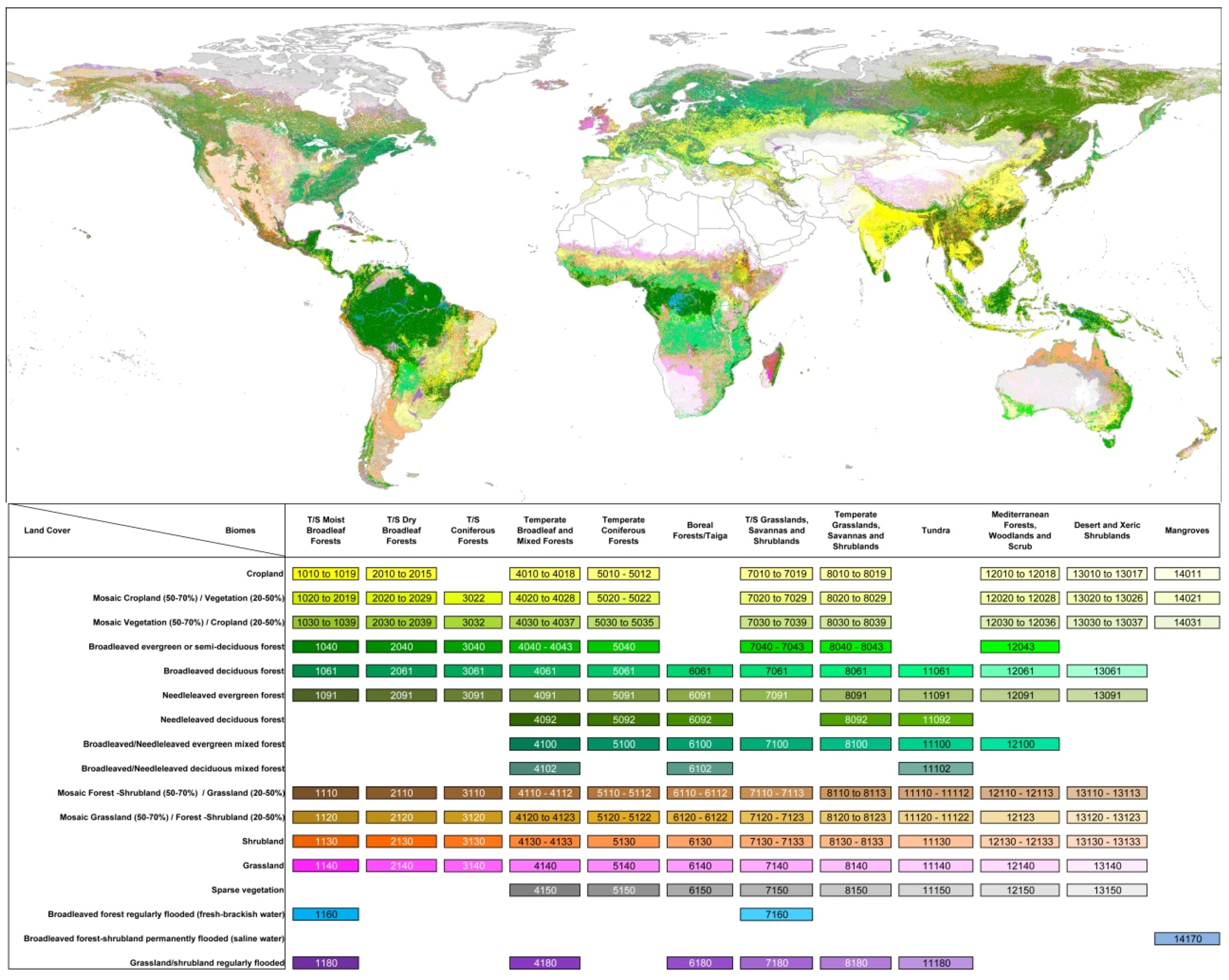
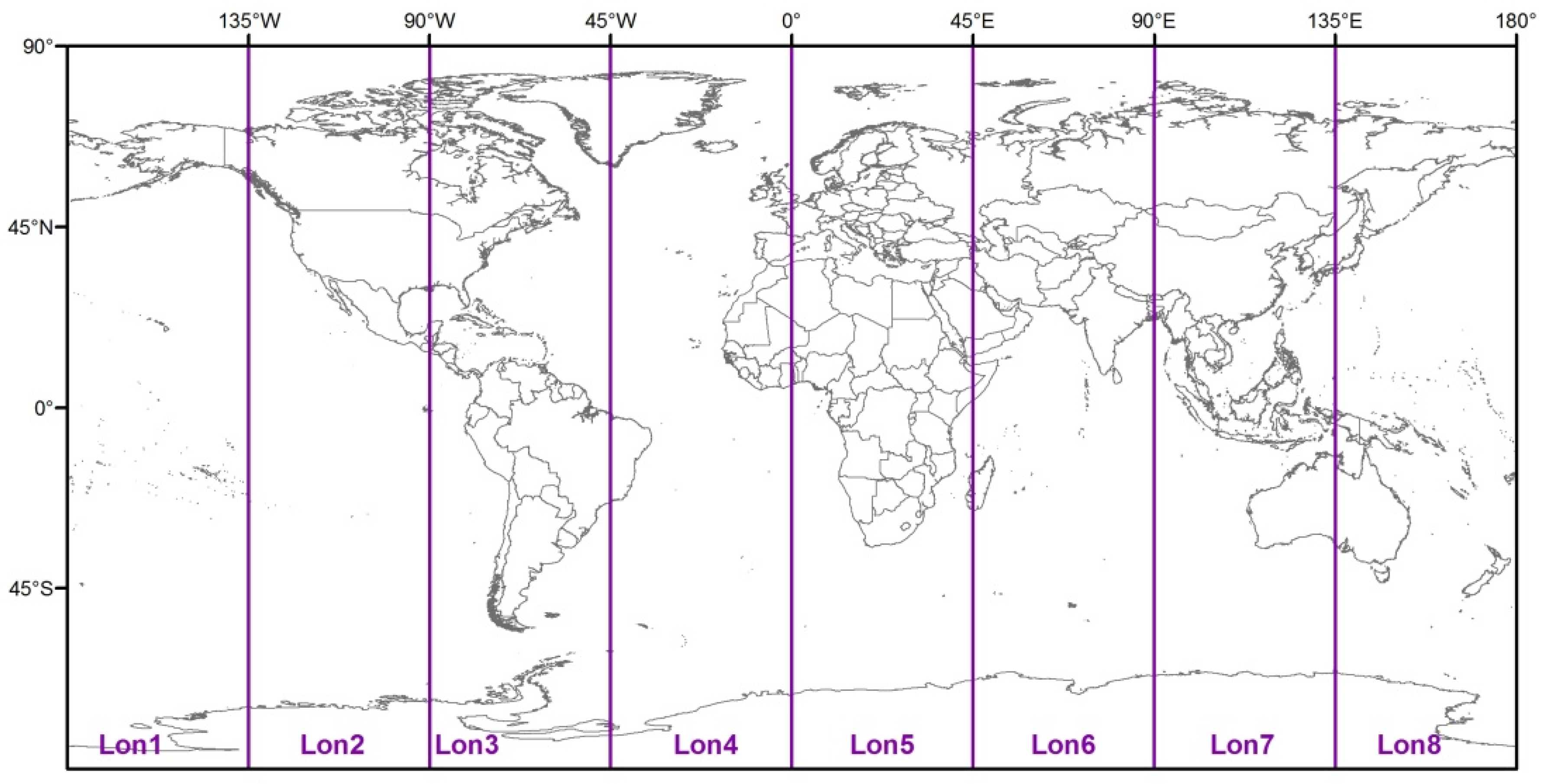
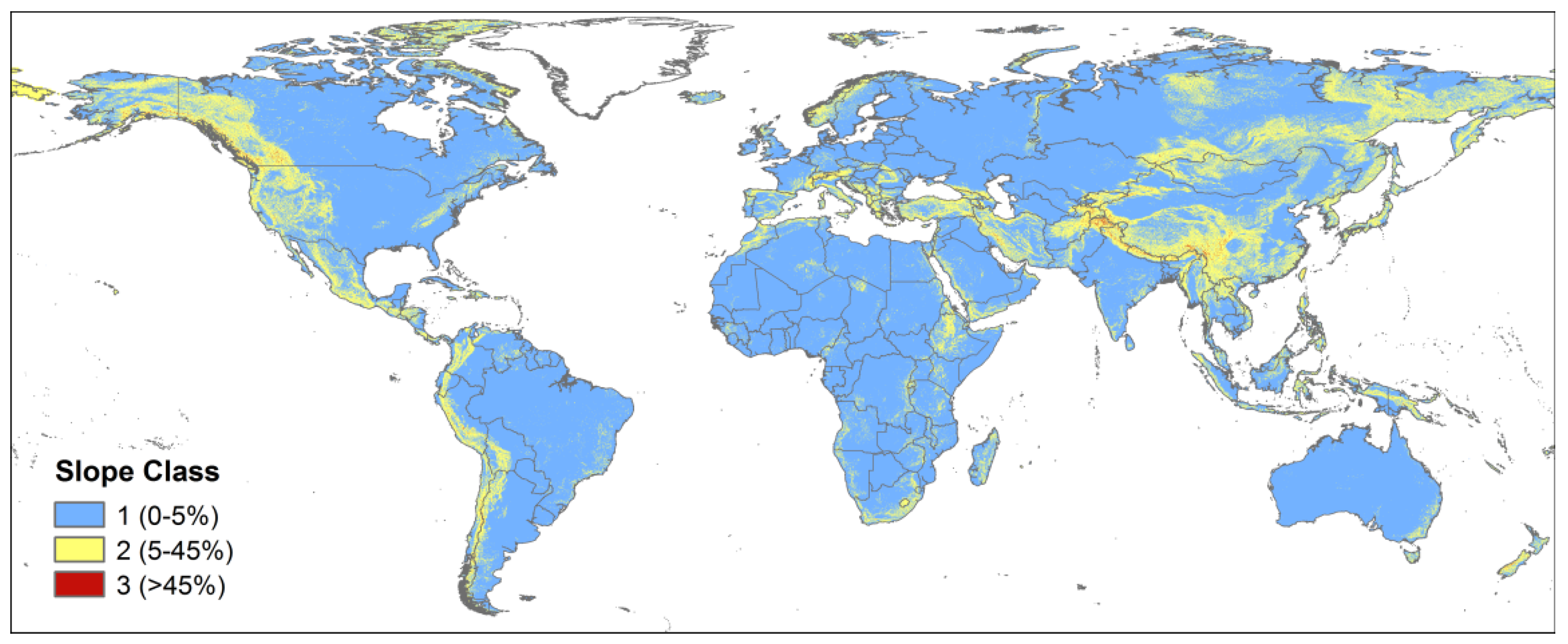
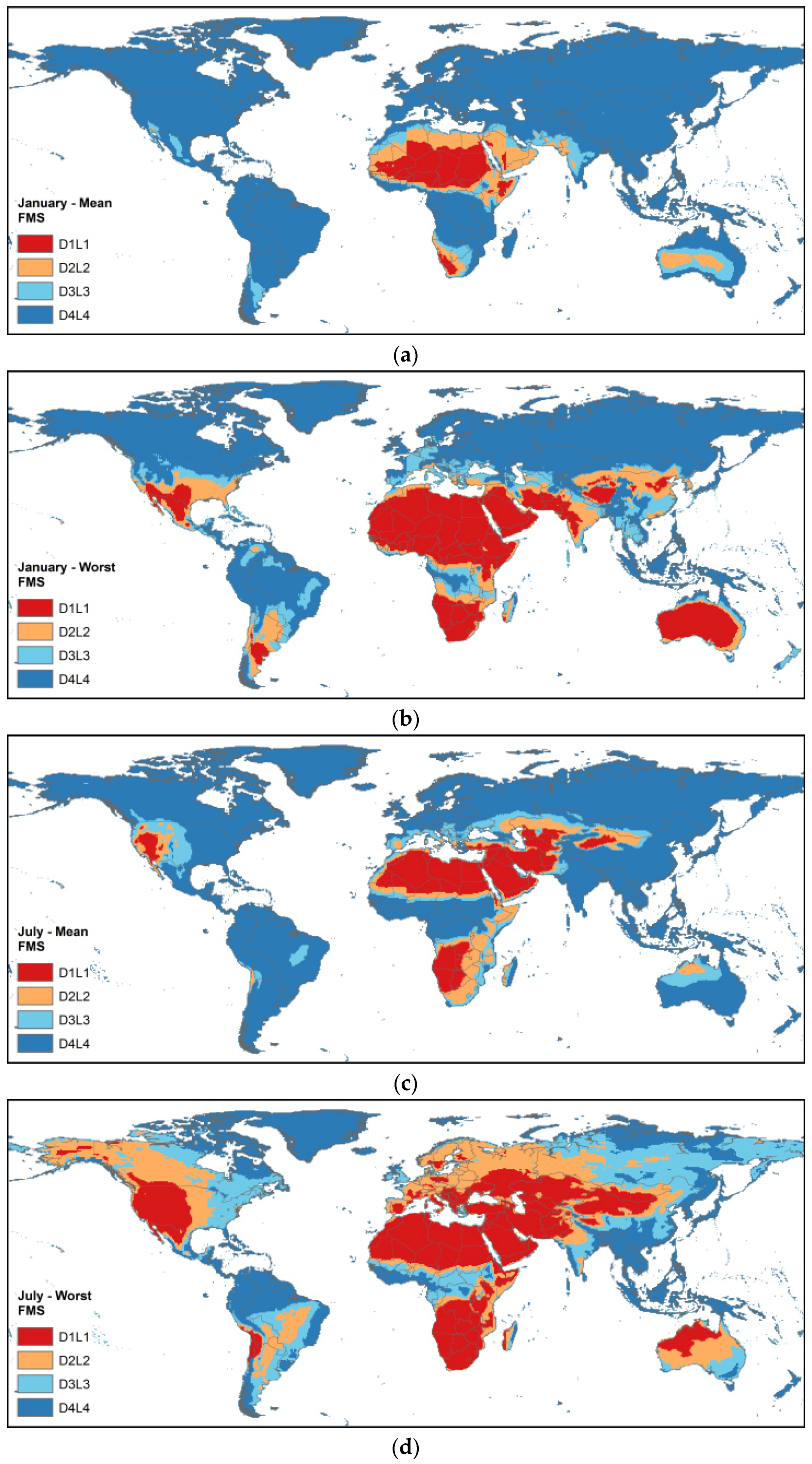
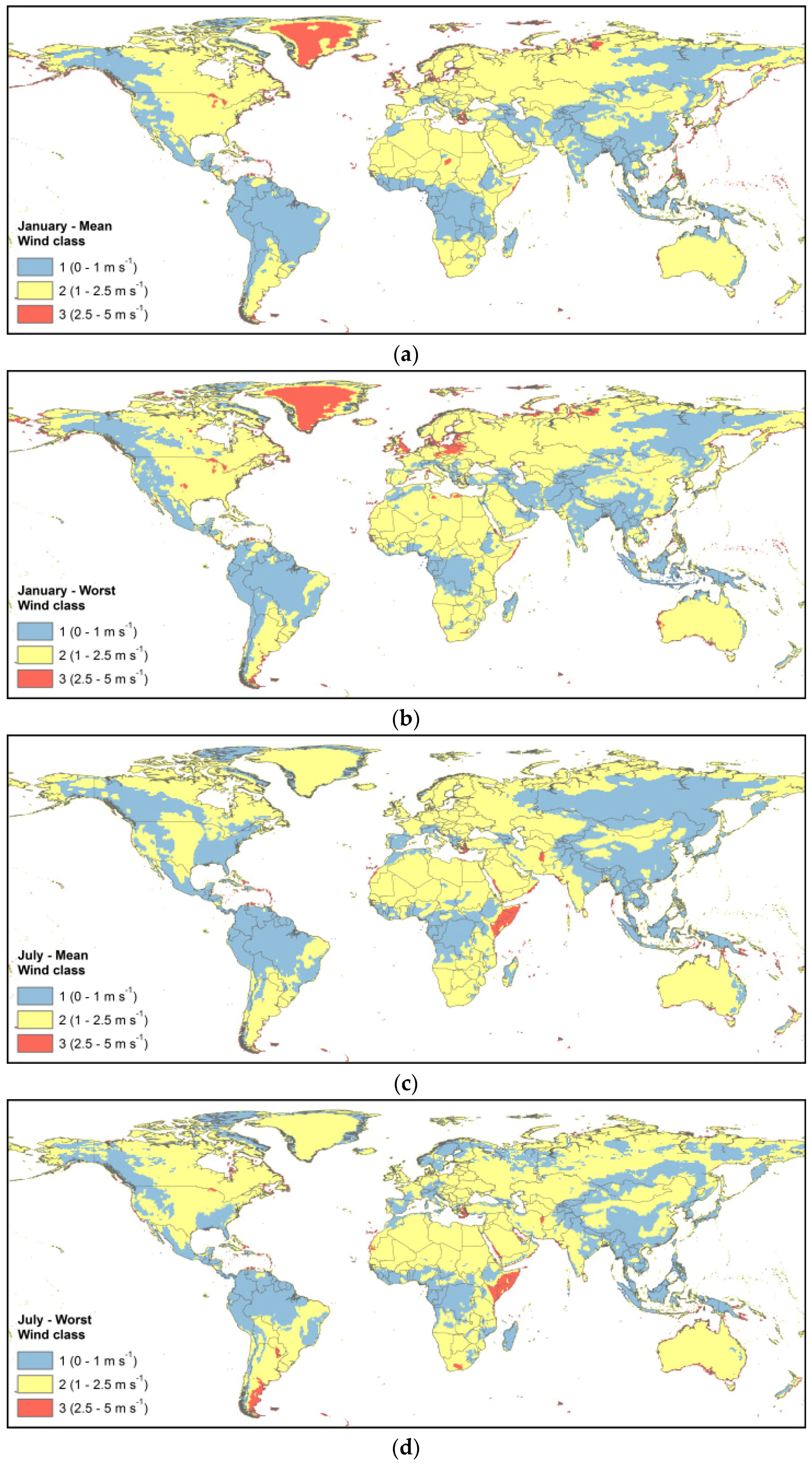
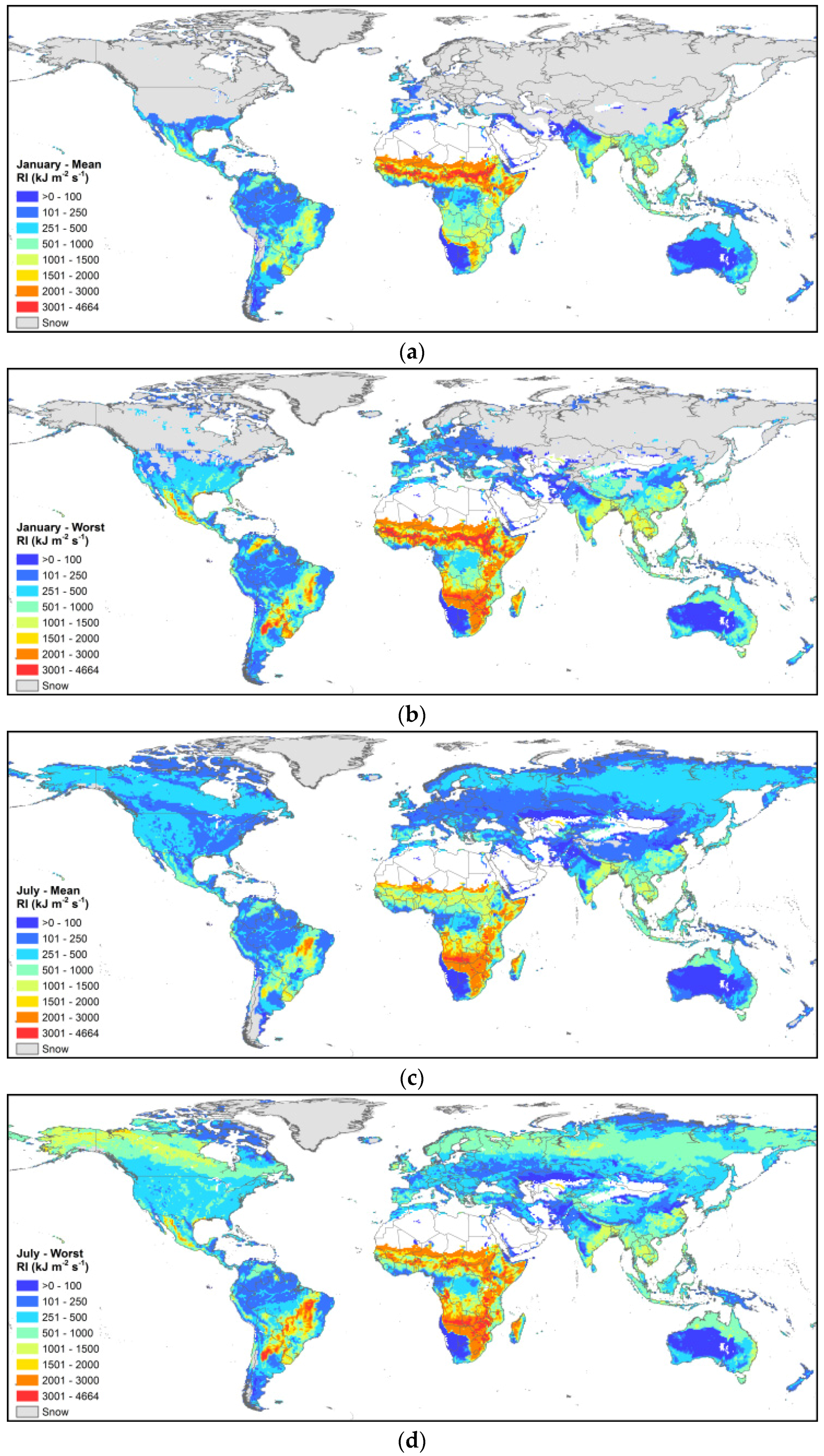

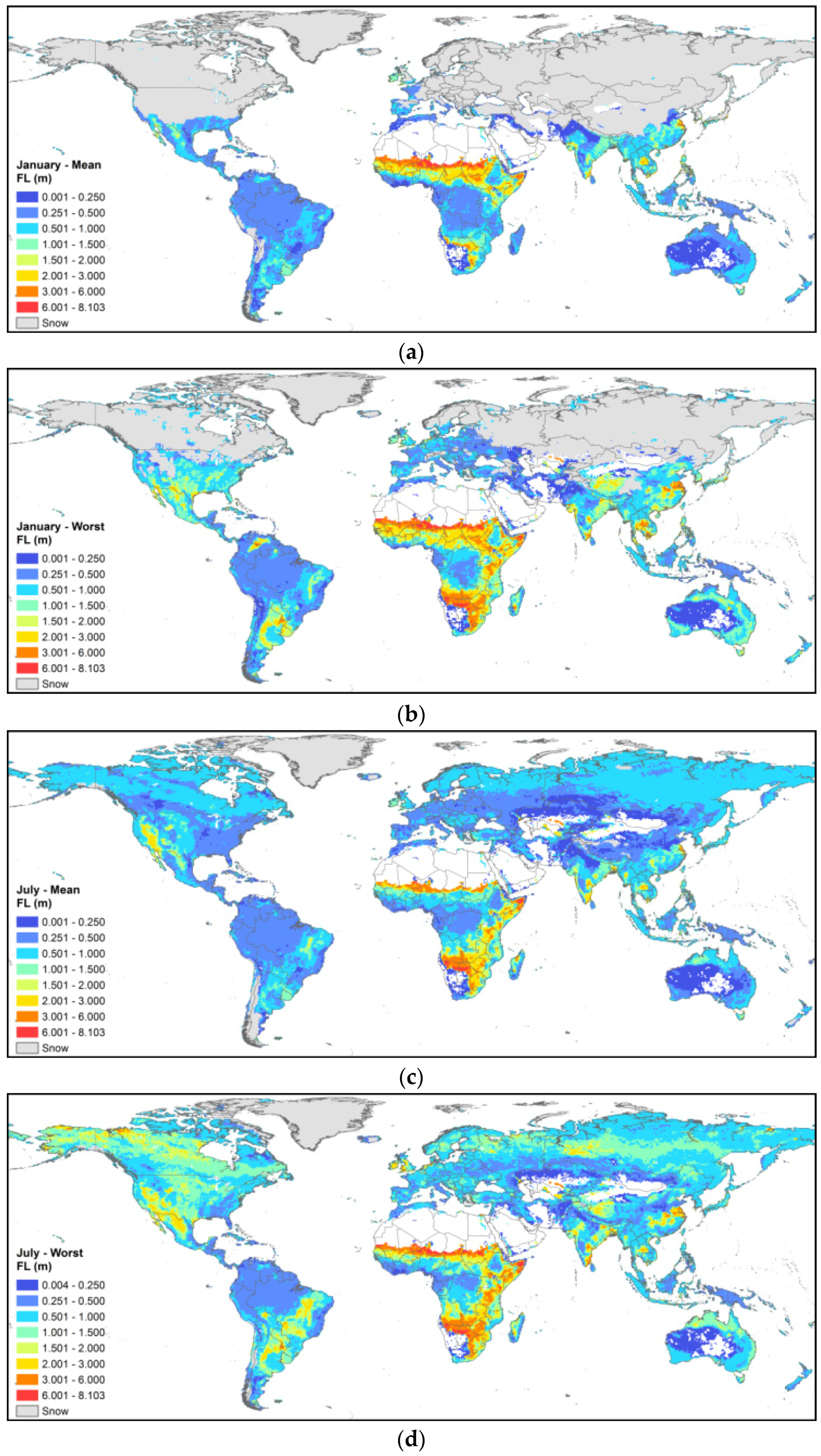
| Strip | Longitude | UTC | Forecast Time | Step |
|---|---|---|---|---|
| Lon1 1 | 180–135 W | 0 | 0 | 0 |
| Lon2 | 135–90 W | 3 | 0 | 3 |
| Lon3 | 90–45 W | 6 | 0 | 6 |
| Lon4 | 45–0 W | 9 | 0 | 9 |
| Lon5 | 0–45 E | 12 | 0 | 12 |
| Lon6 | 45–90 E | 15 | 12 | 3 |
| Lon7 | 90–135 E | 18 | 12 | 6 |
| Lon8 | 135–180 E | 21 | 12 | 9 |
| Variable Name | Variable Code | Units | Other Information |
|---|---|---|---|
| 10 m U wind component | 165 | m·s−1 | Instantaneous at time step. |
| 10 m V wind component | 166 | m·s−1 | Instantaneous at time step. |
| Total Cloud Cover | 164 | Fraction of cover (0–1) | Instantaneous at time step. |
| Snow Depth | 141 | m of water equivalent | Instantaneous at time step. |
| Total Precipitation | 228 | m of water | Accumulated since the forecast time to the step. |
| 2 m Dew Point | 168 | °K | Instantaneous at time step. |
| 2 m Temperature | 167 | °K | Instantaneous at time step. |
| FMS Code | FMS Description | Fuel Moisture Content (%) | |||||
|---|---|---|---|---|---|---|---|
| Herb | Shrub | Crown 1 | 1 h | 10 h | 100 h | ||
| D1L1 | Very low dead FMC, fully cured herb | 30 | 60 | 60 | 3 | 4 | 5 |
| D2L2 | Low dead FMC, 2/3 cured herb | 60 | 90 | 60 | 6 | 7 | 8 |
| D3L3 | Moderate dead FMC, 1/3 cured herb | 90 | 120 | 120 | 9 | 10 | 11 |
| D4L4 | High dead FMC, fully green herb | 120 | 150 | 150 | 12 | 13 | 14 |
| Environmental Scenario | FMS Code 1 | Wind 2 | Slope 3 | Environmental Scenario | FMS Code 1 | Wind 2 | Slope 3 |
|---|---|---|---|---|---|---|---|
| 1111 | D1L1 | WC1 | SP 1 | 3311 | D3L3 | WC1 | SP 1 |
| 1112 | D1L1 | WC1 | SP 2 | 3312 | D3L3 | WC1 | SP 2 |
| 1113 | D1L1 | WC1 | SP 3 | 3313 | D3L3 | WC1 | SP 3 |
| 1121 | D1L1 | WC2 | SP 1 | 3321 | D3L3 | WC2 | SP 1 |
| 1122 | D1L1 | WC2 | SP 2 | 3322 | D3L3 | WC2 | SP 2 |
| 1123 | D1L1 | WC2 | SP 3 | 3323 | D3L3 | WC2 | SP 3 |
| 1131 | D1L1 | WC3 | SP 1 | 3331 | D3L3 | WC3 | SP 1 |
| 1132 | D1L1 | WC3 | SP 2 | 3332 | D3L3 | WC3 | SP 2 |
| 1133 | D1L1 | WC3 | SP 3 | 3333 | D3L3 | WC3 | SP 3 |
| 2211 | D2L2 | WC1 | SP 1 | 4411 | D4L4 | WC1 | SP 1 |
| 2212 | D2L2 | WC1 | SP 2 | 4412 | D4L4 | WC1 | SP 2 |
| 2213 | D2L2 | WC1 | SP 3 | 4413 | D4L4 | WC1 | SP 3 |
| 2221 | D2L2 | WC2 | SP 1 | 4421 | D4L4 | WC2 | SP 1 |
| 2222 | D2L2 | WC2 | SP 2 | 4422 | D4L4 | WC2 | SP 2 |
| 2223 | D2L2 | WC2 | SP 3 | 4423 | D4L4 | WC2 | SP 3 |
| 2231 | D2L2 | WC3 | SP 1 | 4431 | D4L4 | WC3 | SP 1 |
| 2232 | D2L2 | WC3 | SP 2 | 4432 | D4L4 | WC3 | SP 2 |
| 2233 | D2L2 | WC3 | SP 3 | 4433 | D4L4 | WC3 | SP 3 |
© 2017 by the authors. Licensee MDPI, Basel, Switzerland. This article is an open access article distributed under the terms and conditions of the Creative Commons Attribution (CC BY) license (http://creativecommons.org/licenses/by/4.0/).
Share and Cite
Pettinari, M.L.; Chuvieco, E. Fire Behavior Simulation from Global Fuel and Climatic Information. Forests 2017, 8, 179. https://doi.org/10.3390/f8060179
Pettinari ML, Chuvieco E. Fire Behavior Simulation from Global Fuel and Climatic Information. Forests. 2017; 8(6):179. https://doi.org/10.3390/f8060179
Chicago/Turabian StylePettinari, M. Lucrecia, and Emilio Chuvieco. 2017. "Fire Behavior Simulation from Global Fuel and Climatic Information" Forests 8, no. 6: 179. https://doi.org/10.3390/f8060179







